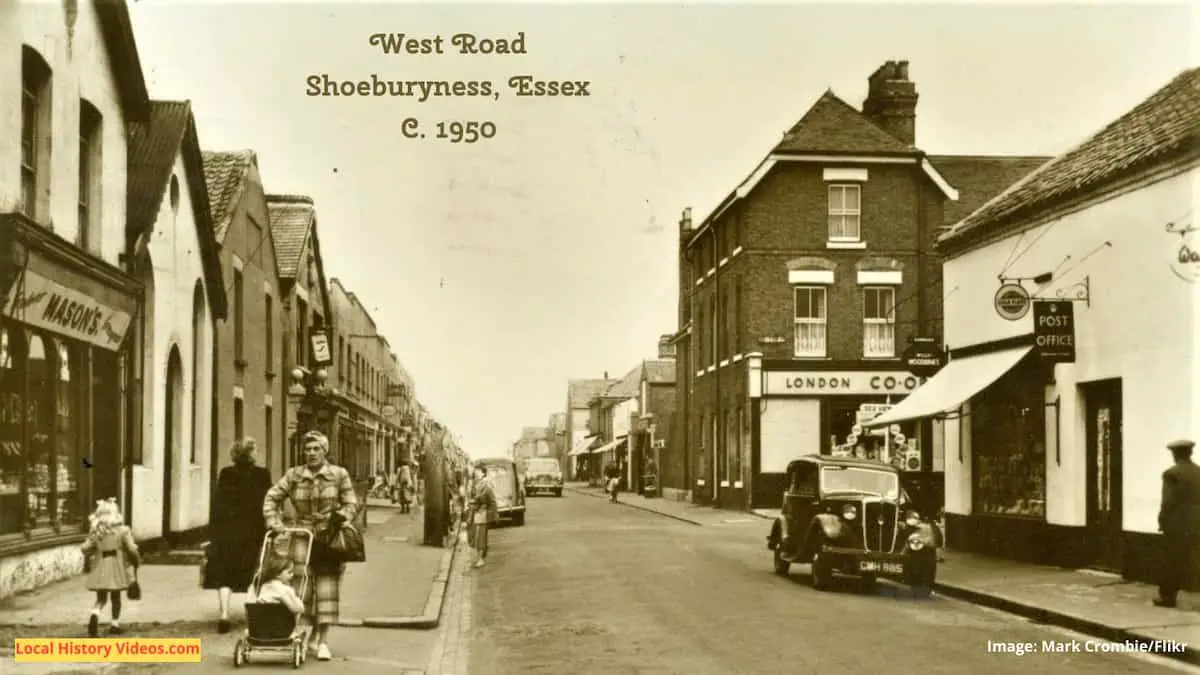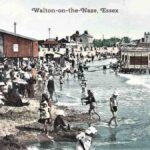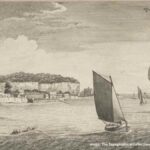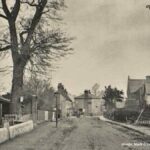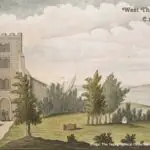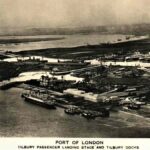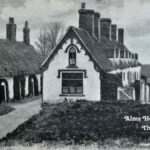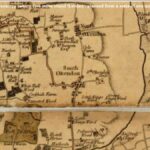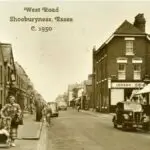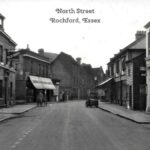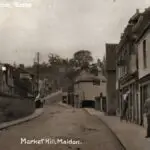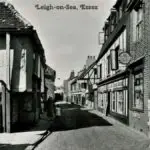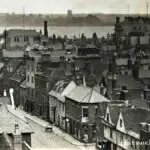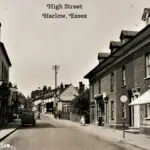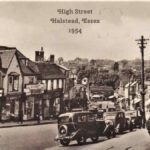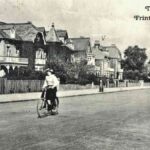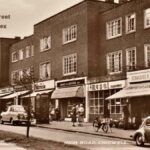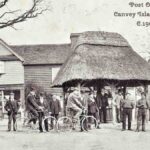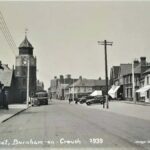Glimpse history through old images of Shoeburyness, Essex, England.
When J. M. W. Turner exhibited his oil painting Shoeburyness Fishermen Hailing a Whitstable Hoy in 1809, the settlement was a quiet fishing village in the Thames Estuary. In 1933, it became part of the county borough of Southend-on-Sea, and is now one of the city’s suburbs.
Football Match 1918
Silent footage records a football match played by the Canadian and Shoeburyness Artillery teams in the final year of the Great War, now known as World War I.
Canadian V Shoeburyness Artillery – Football (1918) – British Pathé on YouTube
1930s Military Preparations
Shoeburyness was once a garrison town, and remains a host to MoD Shoeburyness.
So as Britain prepared for the increasingly likely World War II, the area was an important location for the testing and exhibiting of defensive military technology.
By that time, the area had been hosting new guns experiments and demonstrations for a century, having started during the Crimean War.
Display of Britain’s power as military unloads and fires weapons (1938) – British Pathé on YouTube
Testing British weapons in Shoeburyness (1939) – British Pathé on YouTube
Anderson Shelter 1939
Britain suffered many casualties from the bombing raids of the Great War 1914-1918, and back then planes were still bi-wing. Technology had moved on at an incredible rate since then, and by 1939 the authorities knew the well equipped German airforce was capable of unleashing great harm.
Cities could organise big shelters, but only a small percentage of the civilian population would live near them.
The solution was found in the Anderson shelter. So here was a demonstration recorded for a newsreel, showing how the Anderson shelter would remain intact even as a large building was destroyed within it.
Then we see a brief moment of people trying out the shelter on view at Millbank in London. It’s a tight fit, especially as everyone would be cooped up inside for quite a while.
Bomb Explosion At Shoeburyness – British Movietone on YouTube
Gun Girls of the ATS
This newsreel about the Gun Girls of the ATS is dated 1949, but I wonder if it was 1939?
Their job was spotting and plotting shell bursts at a secret experimental station in the Thames Estuary.
Girl Gunners (1949) – British Pathé
Historic Book
Extract from: Chambers’s Journal of Popular Literature, Science and Arts
Published in 1896
Pages 235 – 236
SHOEBURYNESS .
A FEW years ago we gave in the pages of this
Journal ( No. 380 , April 11 , 1891 ) some
account of Woolwich arsenal , the birthplace
of Woolrich Infants , as the
manufactured
great guns theres
are sometimes fancifully called
and a little later ( No. 452 , August 27 , 1892 )
we described the small – arms factory at Enfield .
It may not be now uninteresting to our readers
if we say something about the portion of the
county of Essex in which experiments are
carried out with the guns , large and small ,
manufactured at these two places , and briefly
mention some of the experiments themselves ,
and their results .
A ness may be best described as a blunt-
shaped , low – lying tongue of land running out
into the sea , hardly a point , much less a
promontory or headland .
The entrance to the
estuary of the Thames is guarded by two such
natural features , exactly opposite to one another .
That to the north is known as Shoeburyness ,
and that to the south is called Sheerness .
Between the two the great river finds its way
to the German Ocean , amidst , especially on the
northern side , shoals and sandbanks Sheerness
is a protected arsenal and dockyard which
guards the mouth of the Medway , and has been
selected for this purpose on account of the
excellent anchorage which the mouth of that
river affords for large ships of war .
Shoebury
ess , on the other hand , has become a military
station , not because of any advantages
afforded by its position on the sea , but because
it consists of a large tract of dreary marshes ,
flanked to the south and east by the far
stretching Maplin sands , which are almost
entirely uncovered at low – water .
These sands
form the attraction from a scientific point of
view , and why so , we shall see later on .
The
place is said to take its name from the words
Sceo and Byrig , which signify – the Byrig , or
settlement , in the shaw or wood .
Here Hast
inge , the viking , constructed one of his sea
coast fortifications or camps , the lines of which
may still be traced .
Of other ancient history
of Shoeburyness there is none .
The first connection of Shoeburyness with
modern military matters appears to have been
made so lately as the time of the Crimean war ,
when the flat , rough marshland was used
as a camping ground for men and horses with
the view of accustoming both to the hard work
which lay before them in the east .
This tract
of country has thus become the property of the
War Department , and that administrative body
soon found another use for it , in which the
half –
submerged sands were to bear an important part .
The idea conceived that targets was
might be erected on these sands , and that the
projectiles which were fired at them might be
recovered at low water . Hence the first con
nection of Shoeburyness with the artillery of
the present day .
A safe range can be found
across the sands to almost any distance , and
these marshes have therefore become the stage
on which our great guns , such as Armstrongs
and Whitworths , have made , so to speak , their
first debut .
To reach Shoeburyness we take the railway
which runs along the south coast of Essex and
the northern bank of the Thames .
As we near
the mouth of the estuary we pass Southend ,
beloved of trippers , with its pier stretching
out in its length of over a mile , and then
cross the base of the ness itself , until we
reach the sea again .
On the south – eastern face
of the ness we are at our journey’s end , and
the railway also , so far as the general public is
concerned , has come to a full stop .
We walk
through the little town or village , and on the
further side find what we may call the original
settlement of gunnery experiments , now for the
most part a group of barracks and quarters
such as we might find at any military station .
A few differences we notice , however , for as we
pass through the barrack – yard we observe that
one building is labelled Lecture – room , and
other evidences there are here and there that
the artillerymen who are quartered here are
not altogether engaged in their ordinary duties .
We shall probably not linger long at the
barracks , but we shall not fail to observe that
the officers ‘ quarters and mess – room occupy an
extremely pleasant position on a wooded bank
above the sea , and that at high – water the
waves come rippling up to the very trees them
selves .
Further on are the houses appropriated
to married officers , all alike situated on the
pleasant sea – bank .
We note many rowing and
sailing boats lying off the mess – buildings . Alas !
these craft sometimes prove a source of fatality
to some of the young officers who , however well
instructed they may be in their professional
duties , yet know nothing of practical scaman
ship .
Parties of young men in the prime of
life , and just entering one of the finest branches
of the British service , have gone off in high
spirits for an afternoon’s sail , and , caught by
tide , or current , or squall , have never returned .
More fortunate are those who have been able
to make their way from a capsized boat to the
Nore lightship , and there , perhaps , have remained
a day or two until the gale had abated and
they could be taken off .
But it is time we should leave the officers
quarters , and walk round the outside of the
domain .
We see in front of us huge wooden
erections standing on the edge of the shore .
These are conning towers from which , when
practice is going on , a view is obtained of the
direction of the shot .
Beneath them are the
batteries from which the guns are fired , and
here go on the courses of instruction in
practical artillery work , which are necessary for
newly – joined officers .
But we have by no means seen the most
important part of Shoeburyness when we have
visited the barracks and the batteries .
We
notice that a line of rails winds its way in and
out amongst guns and storehouses , and if we
have timed our visit right , we shall find a little
miniature train just about to start for what is
called The New Range . Taking our places in
this train , we shall be carried first through the
village and past the terminus of the public line ,
and then by a private railway which winds
along amongst the corn – fields , until we reach
a retired spot on the sea – shore hemmed in by
lofty trees .
In this private place are carried
on all the experiments for which Shoeburyness
is famous , and here both guns and explosives
are tested to their utmost capability .
It is not altogether an unpicturesque spot at which we have arrived. Grouped together in
the shaw to which we have referred , there are certain nice old farmhouses and other
buildings which have been taken possession of
by the military .
The space in front would no
doubt be an admirable rabbit – warren , only the
whole ground is now covered by guns of various
sizes , targets , shields , breast – works , and models
of portions of iron – clad and other vessels .
Amongst these run lines of rails by which
guns and materials can be moved to any part
of the ground ; and in places there are over
head travelling cranes by which heavy cannon
may be hoisted on to or off from their carriages ,
or into trucks , as need may require ; and we
again see lofty couning – towers , though target
practice at a distance is not carried on here to
the same extent as it is in that portion of the
establishment which we first visited . The work
at The New Range is connected rather with
experiments as to the force of explosives and
the penetrating power of projectiles , than with
accuracy of aim and the direction of the shot .
We onght first to say a few words about modern
explosives . Old – fashioned gunpowder , or black
powder , as it is now usually called , is composed
of saltpetre , charcoal , and sulphur , mixed together
in the proportion usually of seventy – five , fifteen ,
and ten parts respectively . But explosives of the
present day are composed of other substances .
Cordite ( Journal , No. 605 , August 3 , 1895 ) , of
which we now hear so much , is made of
nitro – glycerine , gun – cotton , and mineral jelly
in the proportion of fifty – seven , thirty – eight ,
and five parts It is also steeped in a
preparation of acetone . Gun – cotton itself is
dipped in a mixture of three parts of sulphuric
to one of nitric acid . The force of conlite over
gunpowder may be judged from the following
facts . A cartridge containing seventy grains of
black powder fired in the ordinary rifle of the
army will give what is called a muzzle velocity
of one thousand three hundred and fifty feet a
secon – i , while thirty grains only of cordite will
give a velocity of two thousand feet . In larger
arms , a little less than a pound of condite fired
in a twelve – pounder gun will give more velocity
than four pounds of black powder fired in the
same weapon . It need hardly be said that in
the experiments at Shoeburyness it is the new
fashioned explosive which is chiefly used .
More about Essex
- Old Images of Essex, England
- Old Images of West Hangingfield, Essex
- Old Images of Purfleet (Purfleet-on-Thames), Essex
- Old Images of Wickford, Essex
- Old Images of West Thurrock, Essex
- Old Images of Walton-on-the-Naze, Essex
- Old Images of Tilbury, Essex
- Old Images of Thaxted, Essex
- Old Images of South Ockenden, Essex
- Old Images of Shoeburyness, Essex
- Old Images of Rochford, Essex
- Old Images of Maldon, Essex
- Old Images of Leigh-on-Sea, Essex
- Old Images of Harwich, Essex
- Old Images of Harlow, Essex
- Old Images of Halstead, Essex
- Old Images of Frinton-on-Sea, Essex
- Old Images of Chigwell, Essex
- Old Images of Canvey Island, Essex
- Old Images of Burnham-on-Crouch, Essex

